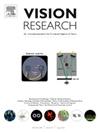Development of foveal crowding in typically developing children and children with developmental dyslexia
IF 1.4
4区 心理学
Q4 NEUROSCIENCES
引用次数: 0
Abstract
Foveal crowding refers to the impaired recognition of a foveal stimulus due to the presence of adjacent flankers. Previous research has produced inconsistent results regarding the maturation of foveal crowding, either at ages 5–7 or remaining elevated from ages 5 to at least 11. We investigated this developmental trajectory using a specialized set of digit stimuli (Pelli fonts) tailored for measuring foveal crowding. We measured foveal crowding in preschoolers, school-age typically developing children, and school-age children with developmental dyslexia, as well as in a group of adults. The results show that foveal crowding decreases with age, reaching adult-like levels around 8 years among preschoolers and typically developing children. Furthermore, dyslexic children exhibited heightened foveal crowding compared to their typical peers by approximately the same amount, regardless of age and reading level. Notably, preschoolers exhibited the most pronounced foveal crowding effects with considerable individual variability: some displayed crowding similar to that of older typical children and adults, while others exhibited similar or even higher levels of crowding compared to dyslexic children. This large variability suggests that foveal crowding may have the potential to serve as an early indicator for identifying developmental dyslexia, a possibility that warrants further longitudinal investigation.
典型发育儿童和发展性阅读障碍儿童中央凹拥挤的发展
中央凹拥挤是指由于相邻侧翼的存在而导致对中央凹刺激的识别受损。先前的研究得出了不一致的结果,关于中央凹拥挤的成熟,要么在5 - 7岁,要么从5岁到至少11岁。我们研究了这种发展轨迹,使用一套专门的数字刺激(Pelli字体)来测量中央凹拥挤。我们测量了学龄前儿童、学龄典型发育儿童、患有发展性阅读障碍的学龄儿童以及一组成年人的中央凹拥挤情况。结果表明,随着年龄的增长,中央凹拥挤程度会降低,在学龄前儿童和正常发育儿童中,中央凹拥挤程度在8岁左右达到与成人相似的水平。此外,无论年龄和阅读水平如何,诵读困难儿童表现出的中央凹拥挤程度与正常儿童相比大致相同。值得注意的是,学龄前儿童表现出最明显的中央凹拥挤效应,具有相当大的个体差异:一些人表现出与年龄较大的典型儿童和成人相似的拥挤效应,而另一些人则表现出与阅读困难儿童相似甚至更高的拥挤水平。这种巨大的可变性表明,中央凹拥挤可能有潜力作为识别发展性阅读障碍的早期指标,这种可能性值得进一步的纵向研究。
本文章由计算机程序翻译,如有差异,请以英文原文为准。
求助全文
约1分钟内获得全文
求助全文
来源期刊

Vision Research
医学-神经科学
CiteScore
3.70
自引率
16.70%
发文量
111
审稿时长
66 days
期刊介绍:
Vision Research is a journal devoted to the functional aspects of human, vertebrate and invertebrate vision and publishes experimental and observational studies, reviews, and theoretical and computational analyses. Vision Research also publishes clinical studies relevant to normal visual function and basic research relevant to visual dysfunction or its clinical investigation. Functional aspects of vision is interpreted broadly, ranging from molecular and cellular function to perception and behavior. Detailed descriptions are encouraged but enough introductory background should be included for non-specialists. Theoretical and computational papers should give a sense of order to the facts or point to new verifiable observations. Papers dealing with questions in the history of vision science should stress the development of ideas in the field.
 求助内容:
求助内容: 应助结果提醒方式:
应助结果提醒方式:


